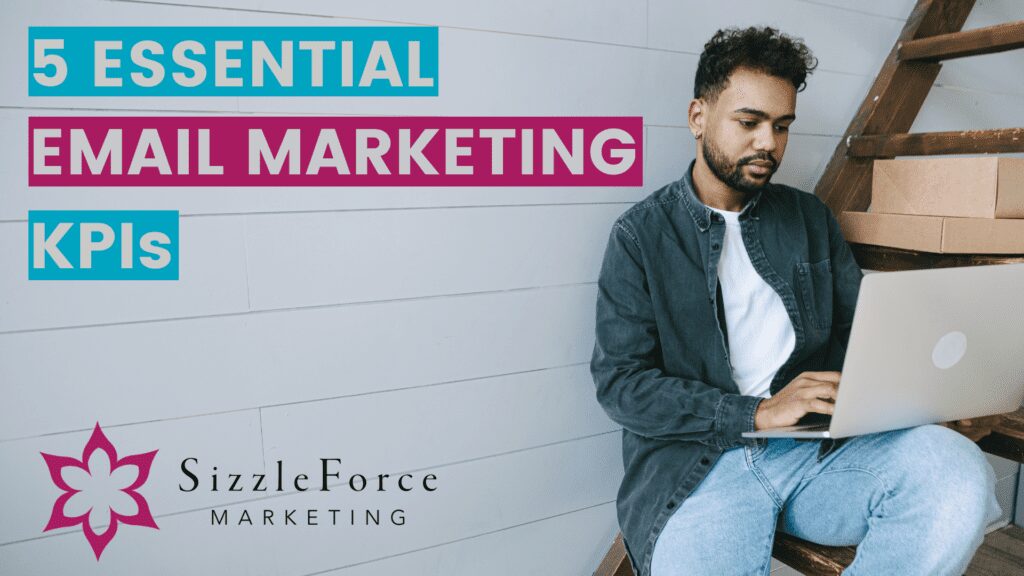

You know that phrase, “hindsight is 20-20”? It’s very true. There’s nothing worse than being confronted by a decision you made that seemed right at the time but didn’t work out so well. That’s why people are obsessed with trying to predict the future.
We have our own means of predicting the future here at SizzleForce Marketing. And it is based on cold-hard science. It’s called a key performance indicator.
Key performance indicators ensure that your email marketing methods are working. With a combination of data and experience, you can make educated guesses about which methods are successful, which aren’t, and use those same metrics to determine what may work in the future.
Marketing is the artistry of understanding what makes quality content and the science of determining what gets results. You can throw marketing campaigns at the wall to see what sticks, but it won’t matter unless you can identify and measure what’s actually sticking. This is especially true of email marketing.
So with that in mind, we are sharing our favorite email marketing KPIs that actually impact your bottom line.
Bounce Rate


The first thing we check when determining if email campaigns are working is the bounce rate.
With bounce rate, it’s not about what went right but what went wrong. It doesn’t matter how great your email is if it doesn’t reach your target audience. If your emails aren’t reaching subscribers, it could indicate a messy list. And if your email list is messy, that will affect your sender’s reputation and in turn, could result in your emails going straight to spam.
There are a few different terms you may see when looking at your bounce rate, but for our purposes today these are the two that are most important:
- Hard Bounce: This is a permanent bounce. It’s frequently caused by an unknown domain or user/syntax error. This hurts your reputation more.
- Soft Bounce: This is a temporary bounce. It may be caused by a temporarily inactive mailbox or temporary domain failure. If the same person on your list soft bounces too often, it can be as damaging as a hard bounce.
The lower your bounce rate, the less likely it is that your emails will go to spam. Ideally, your goal should be around a 2% bounce rate.
The Magic Formula:
Take your number of bounced emails, multiply by the total emails sent and multiply by 100.


Delivery Rate is a KPI that tells you if your emails are being delivered. This is great and all, but knowing if they reached your audience may not be enough. We prefer bounce rate because it will give you an idea of why emails didn’t reach their target audience.
Click-To-Open Rate


The next email marketing KPI that can indicate what’s working is your click-to-open rate (CTOR).
CTOR is a great way to determine if the content is working, as it tells you what percentage of subscribers are engaging with it. A high click-to-open rate means that after opening your email, multiple readers clicked on its contents.
If your CTOR is low, it can indicate that content isn’t resonating with your audience. CTOR percentages vary based on your industry.
The Magic Formula:
Take the number of unique clicks and divide it by the number of unique opens, then multiply that number by 100.


Click-Through Rate
Now, it is time to check your metrics to see what percentage of subscribers clicked any of the links in your emails. Remember:
“If your email captures your audience, they’ll click on your links. If they’re not clicking, you’re not capturing.”
Remember to check both your Total CTR and your Unique CTR. If someone clicks a link five times, your Total CTR will count multiple clicks by the same subscriber. Unique CTR will only each link-click per subscriber once.
The Magic Formula:
Take the number of link clicks and divide it by the number of emails that were delivered. Then multiply that number by 100.


While you’re checking your click-through rate, also check to see how many people have shared and forwarded your email. It’s a great way to harness the power of “word of mouth” marketing and a great gauge of the quality of your content.
Conversions


This cuts to the heart of why we’re writing in the first place. Is your audience responding to the call to action? For some, this may be a new subscriber. For others, this could be a sale.
What’s great about using KPIs to understand how your campaigns are performing is that you can determine what step in your process isn’t working. If the rest of your KPIs are great, but your conversion rate is low you can determine what went wrong through the process of elimination.
A low bounce rate tells you that the email is getting to the people you want it to get to. High click-through rates indicate that the copy is engaging and interesting. So, therefore, the issue with conversions very likely has something to do with the CTA or the page that readers are being redirected to.
The Magic Formula:
To calculate this, you take the number of subscribers who complete your action and divide it by the number of emails delivered. Multiply that number by 100.


I’m not getting enough conversions! What do I do?
List Growth Rate


If you want sustainable growth, then growing your email list is vital. Naturally, your list will experience unsubscribes, and to keep your bounce rate low, you’ll be removing inactive subscribers. Ideally, you should have enough new subscribers to counter those losses.
The Magic Formula:
To calculate this, you take the number of new subscribers and subtract the number of subscribers who leave your list. Then, take that new number and divide it by your total number of subscribers. Finally, multiply by 100 to get your growth rate.


My Email Marketing KPIs are Terrible!
What do I do?
Never fear – there are all kinds of tactics that can be used to improve your metrics. We recommend two ways of tackling this problem. Keep it clean, and keep it moving.
Keep it Clean
- 👏 Clean 👏 your 👏 lists
- Check for obvious typos on your subscriber list
- Remove duplicate emails and hard-bounce emails
- Too many soft bounces is basically a hard bounce. Scrap that address.
- Remove inactive subscribers from your list
Keep it Moving
- Make sure your email is optimized for mobile users as well as desktop users
- Try a call to value instead of a call to action
- Try to limit your emails to 1 CTA per email.
- Avoid bate and switch with click-bate subject lines paired with irrelevant content.
Our Most Important Tip: Don’t get so bogged down in numbers that you forget about content quality.
What makes marketing magic is the balance. Understanding your KPIs is one great way to measure your success and determine what is working within your campaigns. Want another great way to determine how your marketing strategy can be improved? Take Our Quiz!

